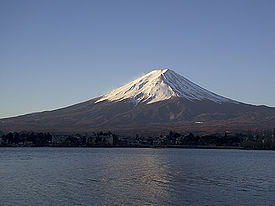- Shintai
-
In Shinto, shintai (神体 body of the kami), or go-shintai (御神体 sacred body of the kami) when the honorific prefix go- is used, are physical objects worshiped at or near Shinto shrines as repositories in which spirits or kami reside.[1] Shintai used in Shrine Shinto (Jinja Shinto) can be also called mitamashiro (御霊代 spirit replacement or substitute).[1]
In spite of what their name may suggest, shintai are not themselves part of kami, but rather just temporary repositories which make them accessible to human beings for worship.[2] Shintai are also of necessity yorishiro, that is objects by their very nature capable of attracting kami.
The most common shintai are man-made objects like mirrors, swords, jewels (for example comma-shaped stones called magatama), gohei (wands used during religious rites), and sculptures of kami called shinzō (神像)[3], but they can be also natural objects such as stones, mountains, trees and waterfalls.[1] Before the forcible separation of kami and Buddhas of 1868 (shinbutsu bunri) a shintai could even be the statue of a Buddhist god.
Famous shintai include the mirror, part of the Imperial Regalia of Japan, Mount Miwa, Mount Nantai, the Nachi Falls, and the Meoto Iwa rocks. Many mountains like Mount Miwa or the Three Mountains of Kumano (Kumano sanzan) are considered shintai and are therefore called shintaizan (神体山, shintai mountain).[4] The most famous shintai of all is doubtless Mount Fuji.[5]
A yokozuna, a wrestler at the top of sumō's power pyramid, is a living shintai. For this reason, his waist is circled by a shimenawa, a sacred rope which protects sacred objects from evil spirits. A kannushi, that is, a Shinto priest, can become a living shintai when during religious ceremonies in his body enters a kami.
The founding of a new shrine requires the presence of either a pre-existing, naturally occurring shintai (for example a rock or waterfall housing a local kami), or of an artificial one, which must therefore be procured or made to the purpose. An example of the first case are the Nachi Falls, worshiped at Hiryū Shrine near Kumano Nachi Taisha and believed to be inhabited by a kami called Hiryū Gongen.[6] In the second, the mitama (spirit) of a kami is divided in half through a process called kanjō and one of the halves is then stored in a yorishiro. This is the process which has led to the creation of networks of shrines housing the same kami, as for example the Hachiman shrine, Inari shrine or Kumano shrine networks.
Because over the years the shintai is wrapped in more and more layers of precious cloth and stored in more and more boxes without being ever inspected, its exact identity may end up being forgotten.[7]
The first role of a shrine is to house and protect its shintai and the kami which inhabits it.[8] If a shrine has more than one building, the one containing the shintai is called honden; because it is meant for the exclusive use of the kami, it is always closed to the public and is not used for prayer or religious ceremonies. The shintai leaves the honden only during festivals (matsuri), when it is put in a "divine palanquin" (mikoshi, a term usually translated in English as portable shrine[9]), and carried around the streets among the faithful.[8] The portable shrine is used to physically protect the shintai and to hide it from sight.[8]
See also
- Yorishiro
Notes
- ^ a b c Shintai, Encyclopedia of Shinto
- ^ Smyers, page 44
- ^ Kami are as a rule not represented in anthropomorphic or physical terms, however numerous paintings and statues representing them have appeared under Buddhist influence.
- ^ Ono, Woodard (2004:100)
- ^ For details on Mount Fuji worship, see Fuji Shinkō, Encyclopedia of Shinto.
- ^ Kamizaka, Jirō. "Hiryū Gongen" (in Japanese). Ministry of Land, Infrastructure and Transport - Kinki Regional Development Bureau. http://www.kkr.mlit.go.jp/wakayama/rekishi/disco131.html. Retrieved 28 March 2010.
- ^ Bocking, Brian (1997). A Popular Dictionary of Shinto. Routledge. ISBN 978-0700710515. http://www.amazon.com/dp/0700710515.
- ^ a b c Scheid, Bernhard. "Schreine" (in German). University of Vienna. http://www.univie.ac.at/rel_jap/bauten/schrein.htm. Retrieved 27 March 2010..
- ^ Progressive English-Japanese/Japanese English Dictionary, 2008, Shogakukan
References
- Encyclopedia of Shinto, Shintai, accessed on September 20, 2009.
- Sokyo Ono, William Woodard (2004). Shinto - The Kami Way. Tuttle Publishing. ISBN 978-0804835572.
- Smyers, Karen Ann (1999). The Fox and the Jewel: Shared and Private Meanings in Contemporary Japanese Inari Worship. Honolulu: University of Hawaii Press. ISBN 0-8248-2102-5. OCLC 231775156.
- Basic Terms of Shinto. Tokyo: Kokugakuin University, Institute for Japanese Culture and Classics. 1985.
Shinto shrine Shinto architecture Buildings - chōzuya or temizuya
- haiden
- heiden
- hokora
- honden / shinden / shōden
- kagura-den
- massha
- sessha
Architectonic elements Styles - hirairi-zukuri
- tsumairi-zukuri
- gongen-zukuri
- hachiman-zukuri
- hiyoshi-zukuri
- irimoya-zukuri
- ishi-no-ma-zukuri
- kasuga-zukuri
- kibitsu-zukuri
- misedana-zukuri
- nagare-zukuri
- ōtori-zukuri
- owari-zukuri
- ryōnagare-zukuri
- shinmei-zukuri
- sumiyoshi-zukuri
- taisha-zukuri
Others Implements Main kami Staff Head shrines1 - Fushimi Inari Taisha
- Usa Hachiman-gū
- Ise Grand Shrine
- Dazaifu Tenman-gū
- Munakata Taisha
- Suwa Taisha
- Hiyoshi Taisha
- Kumano Nachi Taisha
- Tsushima Shrine
- Yasaka Shrine
Miscellaneous 1 (in order of the size of the shrine network they head)
Categories:- Shinto
- Japanese religions terms
Wikimedia Foundation. 2010.

